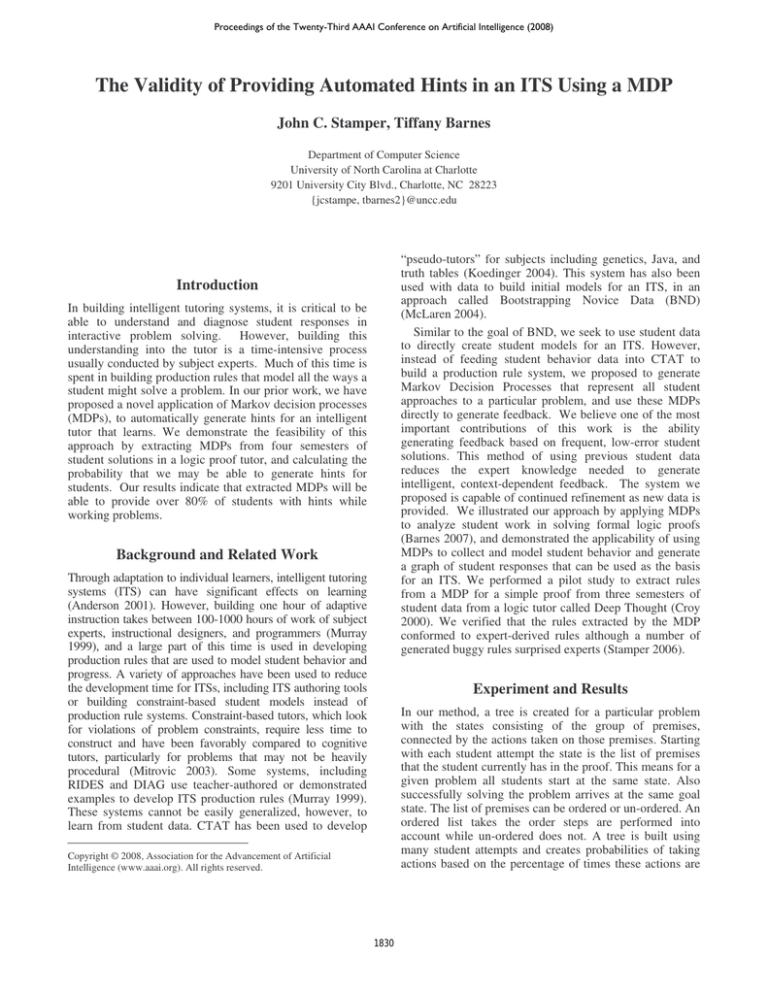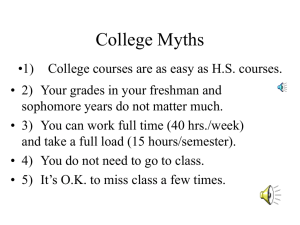
Proceedings of the Twenty-Third AAAI Conference on Artificial Intelligence (2008)
The Validity of Providing Automated Hints in an ITS Using a MDP
John C. Stamper, Tiffany Barnes
Department of Computer Science
University of North Carolina at Charlotte
9201 University City Blvd., Charlotte, NC 28223
{jcstampe, tbarnes2}@uncc.edu
“pseudo-tutors” for subjects including genetics, Java, and
truth tables (Koedinger 2004). This system has also been
used with data to build initial models for an ITS, in an
approach called Bootstrapping Novice Data (BND)
(McLaren 2004).
Similar to the goal of BND, we seek to use student data
to directly create student models for an ITS. However,
instead of feeding student behavior data into CTAT to
build a production rule system, we proposed to generate
Markov Decision Processes that represent all student
approaches to a particular problem, and use these MDPs
directly to generate feedback. We believe one of the most
important contributions of this work is the ability
generating feedback based on frequent, low-error student
solutions. This method of using previous student data
reduces the expert knowledge needed to generate
intelligent, context-dependent feedback. The system we
proposed is capable of continued refinement as new data is
provided. We illustrated our approach by applying MDPs
to analyze student work in solving formal logic proofs
(Barnes 2007), and demonstrated the applicability of using
MDPs to collect and model student behavior and generate
a graph of student responses that can be used as the basis
for an ITS. We performed a pilot study to extract rules
from a MDP for a simple proof from three semesters of
student data from a logic tutor called Deep Thought (Croy
2000). We verified that the rules extracted by the MDP
conformed to expert-derived rules although a number of
generated buggy rules surprised experts (Stamper 2006).
Introduction
In building intelligent tutoring systems, it is critical to be
able to understand and diagnose student responses in
interactive problem solving. However, building this
understanding into the tutor is a time-intensive process
usually conducted by subject experts. Much of this time is
spent in building production rules that model all the ways a
student might solve a problem. In our prior work, we have
proposed a novel application of Markov decision processes
(MDPs), to automatically generate hints for an intelligent
tutor that learns. We demonstrate the feasibility of this
approach by extracting MDPs from four semesters of
student solutions in a logic proof tutor, and calculating the
probability that we may be able to generate hints for
students. Our results indicate that extracted MDPs will be
able to provide over 80% of students with hints while
working problems.
Background and Related Work
Through adaptation to individual learners, intelligent tutoring
systems (ITS) can have significant effects on learning
(Anderson 2001). However, building one hour of adaptive
instruction takes between 100-1000 hours of work of subject
experts, instructional designers, and programmers (Murray
1999), and a large part of this time is used in developing
production rules that are used to model student behavior and
progress. A variety of approaches have been used to reduce
the development time for ITSs, including ITS authoring tools
or building constraint-based student models instead of
production rule systems. Constraint-based tutors, which look
for violations of problem constraints, require less time to
construct and have been favorably compared to cognitive
tutors, particularly for problems that may not be heavily
procedural (Mitrovic 2003). Some systems, including
RIDES and DIAG use teacher-authored or demonstrated
examples to develop ITS production rules (Murray 1999).
These systems cannot be easily generalized, however, to
learn from student data. CTAT has been used to develop
Experiment and Results
In our method, a tree is created for a particular problem
with the states consisting of the group of premises,
connected by the actions taken on those premises. Starting
with each student attempt the state is the list of premises
that the student currently has in the proof. This means for a
given problem all students start at the same state. Also
successfully solving the problem arrives at the same goal
state. The list of premises can be ordered or un-ordered. An
ordered list takes the order steps are performed into
account while un-ordered does not. A tree is built using
many student attempts and creates probabilities of taking
actions based on the percentage of times these actions are
Copyright © 2008, Association for the Advancement of Artificial
Intelligence (www.aaai.org). All rights reserved.
1830
solutions to a problem, the method would already be
capable of automatically generating hints for 50% student
states.
seen at a given state by the actual student attempts. Then
using value iteration, values are assigned to each state. We
start by assigning the goal state a high value (100 in our
trials) and error states a negative number as a penalty (-10)
in our case. All other states are given an initial value of
zero. A transition cost of -1 is applied. After running the
value iteration algorithm, the result is a MDP where each
state has a value which describes how “good” the state is in
relation to achieving the goal. We can give help in the form
of hints from a given state by examining the action leading
to the state with the best value from a given state. The hint
is composed of the action, the resulting state, or a
combination of both.
For this experiment, we used data from four fall
semesters (2003-2006) of a discrete math course at NC
State University. The number of students in each semester
was 240, 263, 262, and 128. Students in this course are
typically engineering and computer science students in
their second or third year of college, but most have not
been exposed to a course in logic. Students attend several
lectures on propositional logic and complete an online
homework where students complete truth tables and fill in
the blanks in partially completed proofs. Students then use
the Proofs Tutorial to solve 10 proofs, directly or using
proof by contradiction. Fifty-eight percent of students used
direct proof when solving proof 1. We extracted 523 of
students’ first attempts at direct solutions to proof 1 from
the Proofs Tutorial.
Our hypothesis was that the method would ramp up
quickly on the ability to give hints. The experiment setup
follows. First, take a group of student attempts. Next,
randomly pick one and use it to seed the state list. Then,
from the remaining group randomly pick another attempt
and see how many states in the attempt are available in the
state list. These are the states we can give hints. Finally,
add the new states to the state list and repeat for all of the
remaining attempts. Repeat this procedure many times and
the result will be the percent average of hint availability.
The results summarized in table 1, show the experiment
run on the group of 523 students for problem 1 in the
NCSU dataset. The procedure was repeated 100,000 times
to smooth the graph. Clearly, the availability to give hints
ramps up very quickly. For un-ordered states (states where
the order premises are created does not matter) the 50%
threshold is reached at just 8 student attempts and the 75%
threshold at 49 attempts. For ordered (where the sequence
of creation matters), 50% occurs on attempt 11 and 75% on
attempt 88.
Hint Percentage
Un-Ordered
Ordered
50%
75%
85%
8
46
154
360
11
85
362
N/A
Conclusions and Future Work
This work has verified that our method of using a MDP to
automatically generate hints will cover the most common
student approached with a very few number of student
problem attempts. The next step is to integrate the
approach into the actual computer based training. Once
this is complete, experiments to determine the usage and
effectiveness of the generated hints will be evaluated.
References
Anderson, J., Gluck, K. 2001. What role do cognitive
architectures play in intelligent tutoring systems? In D.
Klahr & S. Carver (Eds.) Cognition & Instruction: 25
years of progress, 227-262. Erlbaum.
Barnes, T., Stamper, J. (2007). Toward the Extraction of
Production Rules for Solving Logic Proofs. Papers from
the 2007 AIED Educational Data Mining Workshop, ed.
Joseph E. Beck., Marina Del Rey, CA, July 9, 2007.
Croy, M. 2000. "Problem Solving, Working Backwards,
and Graphic Proof Representation," Teaching Philosophy,
23(2), 169-187.
Koedinger, K. R., Aleven, V., Heffernan. T., McLaren, B.
& Hockenberry, M. 2004. Opening the door to nonprogrammers: Authoring intelligent tutor behavior by
demonstration. Proc. 7th Intelligent Tutoring Systems
Conference, Maceio, Brazil, pp. 162-173.
Murray, Tom. 1999. Authoring intelligent tutoring
systems: An analysis of the state of the art. Intl. J. Artificial
Intelligence in Education, 10: 98-129.
Mitrovic, A., Koedinger, K. & Martin, B. 2003. A
comparative analysis of cognitive tutoring and constraintbased modeling. User Modeling 2003: 313-322.
McLaren, B., Koedinger, K., Schneider, M., Harrer, A., &
Bollen, L. 2004. Bootstrapping Novice Data: Semiautomated tutor authoring using student log files, In Proc.
Workshop on Analyzing Student-Tutor Interaction Logs to
Improve Educational Outcomes, 7th Intl. Conf. Intelligent
Tutoring Systems (ITS-2004), Maceió, Brazil, August 30,
2004.
90%
Table 1 – Hint Availability
Furthermore, the data gives evidence that an instructor
could seed the data to jump start new problems. By
allowing the instructor to enter as few as 8-11 example
Stamper. J. 2006. Automating the Generation of
Production Rules for Intelligent Tutoring Systems. Proc.
Intl. Conf. Computer-Aided Learning (ICL2006). Austria,
Sep. 27-29, 2006.
1831




